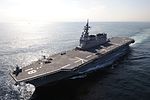Kaiserliche Marine
| Imperial Navy Kaiserliche Marine | |
|---|---|
| Active | 1617- present |
| Country | |
| Branch | Navy |
| Type | Green Water Navy |
| Role | Naval warfare |
| Size | 25,000 115 commissioned ships |
| Part of | Lunderfrausian Armed Forces |
| Garrison/HQ | Sandusky, Lunderfrau |
| Motto(s) | "für Kaiserin und Land" |
| Commanders | |
| Kaiserin of Lunderfrau | Elise Von Strauss |
| First Sea Lady | Frieda von Tirpitz |
The Lunderfrausian Navy ,(Lunderfrausian:Kaiserliche Marine lit. 'Imperial Navy') is the maritime arm of the Lunderfrausian Armed Forces. Founded in 1617, it is one of the oldest Naval Forces in the world. Initially one of the most powerful Navies on the planet, it was greatly reduced in size and scope after the Olympic War.Today the Lunderfrausian Navy is considered to be an up and coming green water navy. As of February 2021, the Lunderfrausian Navy employed 25,000 individuals and consists of 115 active ships. The Navy is based in the port town of Sandusky, Lunderfrau, located 60 (100km) miles west of Salzewinde.
History
Origins
For the first two centuries of its existence, the Matriarchy of Lunderfrau did not have a standing naval force. Instead relying on pressing merchant ships and other vessels into servie during times of need. This was still a rare occurrence as the major conflicts of the 15th and 16th Century that Lunderfrau found itself in, such as the Lunder Conquests had limited naval actions that required a standing fleet.
Demand for a standing Navy began to increase after the expulsion of Lunderfrau from Orthuria in 1580 by Parthonopian and Aridian forces. Increased activity on the Bastion Islands, just 60 nm from Salzewinde by the Produese (who had claimed and settled the islands) in the late 16th Century only cemented this need. Despite this, popular opinion from both the Kaiserin Julia von Klein and the nobility prevented any action on the matter.
The 20 years War
With the Invasion of the Bastion Islands in 1612 and the subsequent Naval Defeat at the Battle of West Bastion in 1613. The Matrairchy found its typical strategy of hobbling together a rag tag fleet of Merchant ships, privateers and mercenaries incapable of handling the brutal efficiency of the Produese Armada, which arrived to reinforce the islands in 1613. Even with the loss of the Bastion Islands in 1613 along with the intermittant raiding of Lunderfrau's coastal towns, it was not until the failed Produese invasion of Lunderfrau in summer of 1617 that Julia put forward the creation of the Kaiserliche Marine.
With the construction of 10 Galleons by the 1620, the Kaiserliche Marine found itself ready and prepared to oust the Produese ships protecting the Bastion Islands. Inititally favoring hit and run attakcs and avoiding large scale conflict. Commander Gretel Engel eventually lured the larger Produese fleet into a confrontation at the Battle of Salze Bay in 1622. The defeat of the Produese Armada by Engel at Salze Bay proved to be the major turning point in the war, opening up the Bastion Islands to an Invasion by Lunderfrau in Summer of 1623.
Naval action for the duration of the War would be limited to mostly sporadic privateer actions and repulsing attempts by Produese forces to retake the islands. Ultimately the Battle of Salze Bay would prove to be the deciding factor of the war, crippling Produzland's ability to maintain naval superiority in the Esketres. Ultimately the Kingdom of Produzland would concede the Islands to Lunderfrau in 1632, ending the War.
Ships
| Name | Image | Origin | Type | No. of Units | |
|---|---|---|---|---|---|
|
Carriers | |||||
| Kristina Class | 
|
Velkanika | Helicopter Carrier | 2 | |
|
Destroyers | |||||
| Ardenne Class | 
|
Velkanika | Guided Missile Destroyer | 10 | |
|
Submarines | |||||
| Leopard Seal Class | 
|
Lunderfrau | Submarine | 10 | |
|
Frigates | |||||
| Salzewinde Class | 
|
Carelia | Air Defense Frigate | 40 | |
|
Corvettes | |||||
| Type K4 Class | 
|
Lunderfrau | Multipurpose Corvette | 50 | |